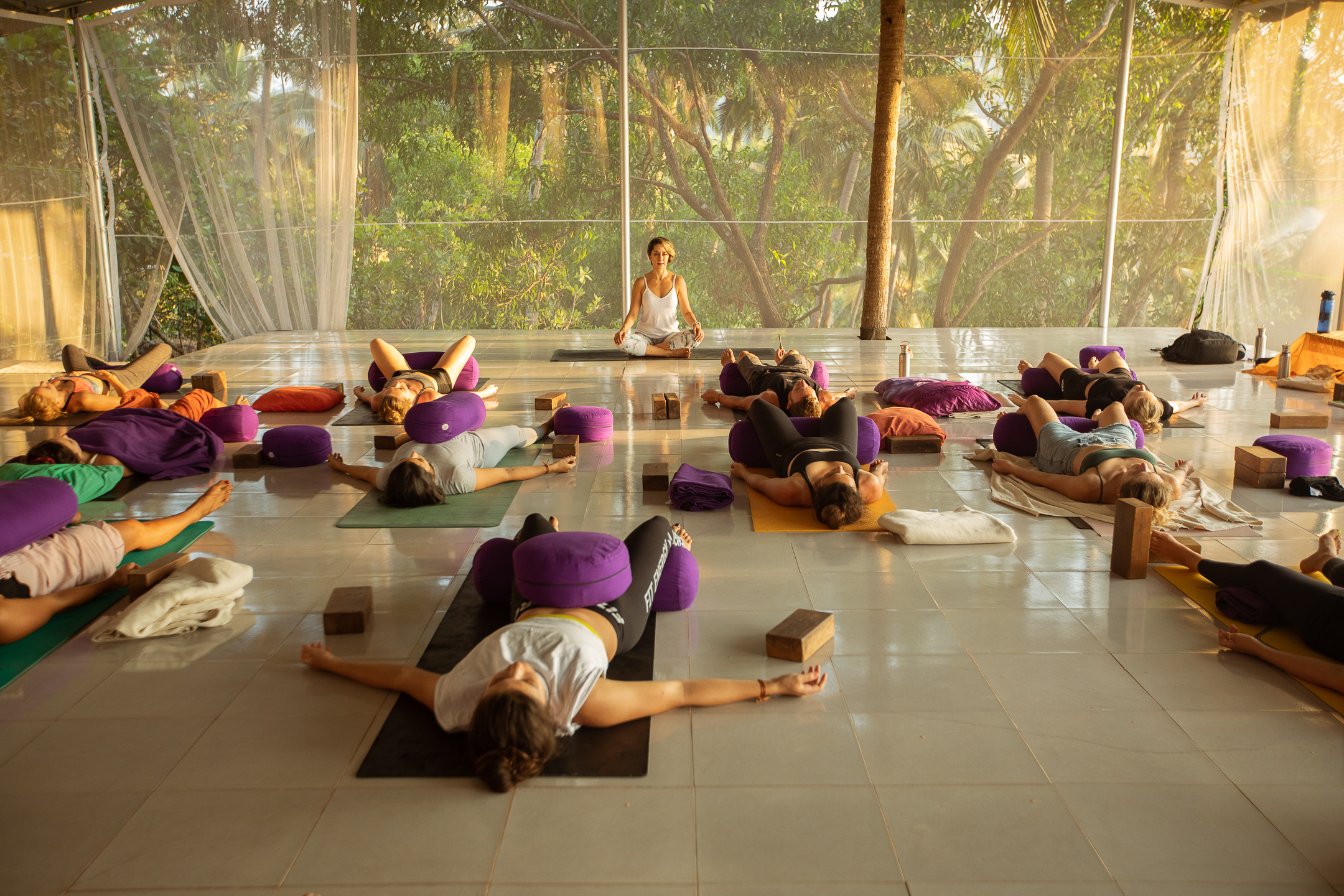Teaching Yin Yoga: 10 Tips for Teachers
Slow-paced and gentle, yin yoga is a practice that stresses the deep connective tissues. It provides a chance to get away from endless to-do lists and de-stress the mind and body, and is suitable for anyone looking to engage in a quiet and reflective practice. In a yin yoga class, since each posture is held for 3-5 minutes, it positively impacts the deep connective tissues (bones, joints, fascia and ligaments) in the body. When these tissues are stretched, they become healthier and stronger. To be an effective teacher it is important to provide the right information as well as guide students in a gentle manner. A 50-hour yin yoga teacher training online explores the different teaching qualities and techniques to make the class effective and enjoyable. While a 50-hour yin yoga TTC is a must to gain this knowledge, this article looks at the key points.

- Monitor comfort levels: During each pose monitor your students comfort level. You can use the system that follows the red, orange, green zone (traffic light system) to observe and judge pain or discomfort. In this system, green means students are completely comfortable in their posture and the effect of the posture is minimal. Orange indicates a mild discomfort and the stimuli are being effective. Red is the danger zone, indicating pain and risk of injuries. In the beginning of the class tell students about the zones, and continuously remind them of the zones throughout the class.Ideally, students should be in the orange zone as this means they are stressing the target area and getting the benefits of the posture. Care must be taken not to crossover to the red zone. To learn how to differentiate between zones, we recommend taking up one of the best Online Yin Yoga Teacher Training programs at Sampoorna Yoga Online Academy.
- Use props effectively: Familiarize yourself with the different props and their purpose. Inform students that props can make a practice more effective when used correctly. For example, a strap will act as a catalyst for practitioners to hold a posture for the intended duration and to even go from the green zone to orange. It even takes stress off the areas that are not actually being targeted in a posture. At the same time, as teachers, ensure the props are not deterring one’s practice. Of course, in our online yin yoga training we will help you learn how props can be used effectively.
- Voice modulation: Similar to modulating your voice between different yogic practices (for example, instructing asanas versus guiding a meditation), in yin yoga modulating your voice is a beneficial skill. Maintaining a firm and clear, yet gentle and soothing voice is helpful. Students will be more receptive and attentive when you are delivering instructions with emotion. Modulating your voice will also keep students from getting bored or zoning out (as the class is slow-paced).
- Create the right ambience: Consider lights, scents and eliminating external noise when thinking of the kind of ambience you wish to create. Remember, keeping your students relaxed yet engaged is the key. So, your atmosphere should be soothing but not boring. Soothing scents like lavender, jasmine or sage are popular relaxants. Avoid anything that is stimulating or too strong. The goal here is to create a safe and warm environment where students feel comfortable experiencing real sensations, feelings and thoughts that come with the practice.
- Focus on function: You don’t want to get stuck on the shape or form. It’s not about the aesthetics of the pose, but what effect the pose has on the mind and body. Repeatedly tell students it is okay to try variations and use props when needed. Teach students to listen to their bodies. Each student’s ideal alignment might differ slightly based on their body shape, weight and height. The key is for students to find what works for them by listening to physical cues, and for you to encourage this. This way, there is less risk of overstraining tissues or injuries. To understand this completely, we recommend doing an online yin yoga teacher training that carries a functional approach to yoga with a strong curriculum in anatomy of movement.
- Transitions are important: As each posture is held for long and there is a deep impact on the connective tissue, exiting a pose can be challenging for students. They might feel various sensations, stiffness or difficulty between postures. Be attentive to how they feel and offer rest time to experience all the rebound when coming out of a pose. Ensure they feel comfortable before moving onto the next pose by allowing them time to concentrate on each movement.
- When to speak and when to stay silent: You are trying to ensure your students have a meditative and calming experience. While instructions are important, so is staying silent. Speaking too much will interrupt a student’s experience and concentration. Try to speak only for 30-40% of the time your students are in a posture. Be short and sweet during transitions. Allow your students the time and space to go inwards. If you are helping an individual student, speak in a low yet clear voice so it doesn’t disturb the others.
- Plan a sequence with modifications and options: Think through your sequence (and practice it) before the class.. This way you can feel if the transitions you created in your mind actually make sense in your body. Account for counterposes and beginner to advanced versions. Consider starting with more accessible postures and variations, and offer two to three options per pose. This way, students will feel like they are working around the body in a logical way. Depending on your theme of the class, there may be a deeper focus on a specific area. So, it is important to add the right variety of poses to work through that region and to offer counterposes to balance it out.. For example, in a lower body routine, you will want to cover everything from the hip to the foot, so there is a full experience for each leg.
- Give time for rebound: Rebound refers to experiencing the effect of the pose. It gives the body time to relax and recover from the position it was in. During this phase, blood flow to the stimulated area increases. Skipping rebound time takes away the experience and does not allow the specific region to come back to normal. It can also lead to injuries, soreness or strain in the affected area. This also happens during transitions. Since there was a fair amount of stress on the connective tissues, students need this time to recover and restore. If you are unsure how to account for rebound time, just pause when releasing the posture, allow your students to remain in stillness and observe anything that may arise. In a yin yoga certification online you can learn more about rebound time.
- Offer guidance and adjustments: Make poses accessible for all students by offering variations and adjustments. It can get frustrating when poses are too challenging. Asking them to rest and wait is not very encouraging. Instead, offer variations. This way you are also showing students you care about their experience and progress. Show them how to do the pose with the help of props. After all, yoga is for all.
A yin yoga class can be a wonderful experience. As a teacher, approach your classes without expectations. Don’t overthink how the class will unfold. There should be no room for negative thoughts or feelings of ego, impatience or lack of interest. You are a guide to your students and your goal should be to support them in their journey, irrespective of their level, body structure or anything else. A yin yoga TTC online is a great place for you to start.
Contact us if you are interested in learning more about the healing benefits of yin yoga or discovering how you can make it part of your lifestyle. At Sampoorna Yoga Online Academy, you will find specialized help focusing on your well-being, no matter where you are.


